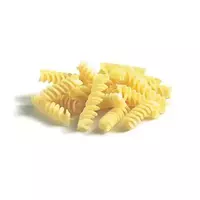Pasta spiral

The fact that in our country is called pasta spiral, in Italy, in the homeland of pasta, is called Rotini. In general, various types of pasta there have names that correspond to their size and shape. In particular, the size of the product is indicated by the ending in the name: oni - large, etti or ette - small, ini - very small.
Pasta spiral (Rotini) is a paste in the form of a corkscrew or, in fact, a spiral. They are round helical pasta, which is approximately
2. 5 to 5 centimeters long. Interestingly, before pasta, a spiral was made by winding spaghetti around a knitting spoke.
Initially, this type of pasta comes from Northern Italy, where they were created specifically for use in conjunction with various sauces. Often, spiral pasta is added to salads (with pesto sauce) or served with tomato-based sauces.
Most often, highly purified (white) wheat flour is used to make pasta spiral, but sometimes they are produced from unpolished rice or other grain crops. In the US, for example, a colloquial spiral pasta is also called Scroodle or simply Scroodle, Skroodle or Scrotini noodles.
Pasta spiral, like many other flour products of this kind, is customary to cook in 2 ways: in a large amount of water - draining and not draining. In the first case, the ratio of water to pasta spiral is 6 to
1. In this case, the water is brought to a boil, salted, and then pasta is lowered into it. The pasta spiral is cooked without a lid at a low boil, stirring periodically.
By the way, the cooking time depends on the size of the pasta spiral, as well as on their composition and degree of drying, in connection with which the readiness of the dish is determined by the practical way - you just need to try them.
Perfectly cooked spiral pasta, which has a slightly stiff core, is called al dente by Italians. When finished, the pasta spiral rests in a colander so that the glasses are water, after which they are filled with oil or sauce - so they do not stick together. What is not interesting: the spiral does not advise washing pasta - this can cause their contamination with microorganisms, as well as loss of nutrients.
Meanwhile, a non-draining way to boil pasta spiral is used if you're going to make a casserole. For this purpose water or mixtures of milk and water are taken in ratio 2 to
1. The pasta spiral is boiled in such a way that completely all the liquid is absorbed into the products.
pasta spiral 345 kCal
Energy value of pasta spiral (Ratio of proteins, fats, carbohydrates - ju):
Proteins: 11.5 g (~ 46 kCal)
Fats: 2.9 g (~ 26 kCal)
Carbohydrates: 67g (~ 268kCal)
Energy ratio (bj | y): 13% | 8% | 78%
 Español
Español Français
Français Português
Português Русский
Русский 简体中文
简体中文 繁體中文
繁體中文 日本語
日本語 한국어
한국어 العربية
العربية Türkçe
Türkçe Қазақ
Қазақ Deutsch
Deutsch Italiano
Italiano Українська
Українська
